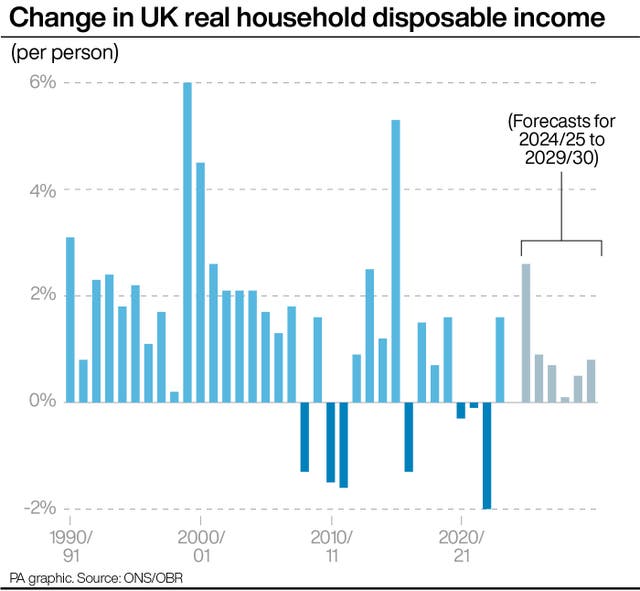
Daniel Barnett 9pm - 10pm
26 March 2025, 18:34

Disposable income growth will vary significantly around the 0.5% five-year average, the OBR said.
UK households will have more disposable income over the next few years, but living standards will stall as businesses pass on higher taxes through lower wages and welfare measures are cut, new forecasts show.
People will be on average £500 a year better off by 2029, compared with previous forecasts, the Government said.
Chancellor Rachel Reeves used her spring statement, delivered to Parliament on Wednesday, to say there will be “more money in the pockets of working people”.

New projections from the Government’s official forecaster, the Office for Budget Responsibility (OBR), show real household disposable income (RHDI) per person will grow at about 0.5% on average each year between 2025 and 2030.
Stronger wage growth means this is higher than the last forecast, which was published in October alongside the autumn Budget statement.
RHDI measures how much spending power people have from their income and savings, taking into account the effect of inflation.
Ms Reeves said working people were “still feeling the pinch” after the cost-of-living crisis, but that the new projections show “living standards will rise twice as fast this Parliament compared to last”.
However, the OBR cautioned that disposable income growth will vary significantly around the five-year average.
It is set to drop sharply from about 2.5% in 2024-25, to almost zero growth in 2027-28.
This will be driven by several factors, the forecasters found, including lower wage growth as firms rebuild their profit margins.
Wages will also be hit by businesses passing on higher employer national insurance contributions to staff, while many workers will also be impacted by so-called “fiscal drag”.
This is when people are dragged into a higher tax bracket if their salaries rise, but thresholds for tax rates stay the same.
Furthermore, living standards will be affected by a rising state pension age and new welfare measures, the OBR found.
Ms Reeves announced further welfare spending cuts in her spring statement, which follows cuts to health and disability benefits set out earlier this month.
After the sharp slowdown, real disposable income growth is forecast to pick up again to average 0.75% a year in 2028-29 and 2029-30.
This will largely be driven by the freeze on income tax thresholds coming to an end, coupled with real wage growth accelerating.
Arnab Bhattacharjee, a research lead for the National Institute of Economic and Social Research (NIESR), questioned how many households will feel better off.
Recent wage increases have largely fallen on higher earners, “leaving working households in the bottom half of the population significantly worse off compared with affluent households”, he said.
“With no substantial initiatives targeting low-income households, the living standards and living conditions of the working poor will continue to stagnate.”